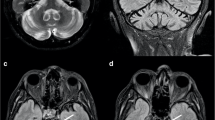Abstract
Spinocerebellar ataxias (SCAs) comprise a clinically and genetically heterogeneous group of autosomal dominantly inherited neurodegenerative disorders affecting the cerebellum and to variable degrees further parts of the nervous system. Electrophysiology is a potent tool to prove impairment of multiple neuronal systems and fibre tracts and even to decipher subclinical affection. Electrooculography, evoked potentials, nerve conduction studies and polysomnography are especially helpful in the setting of SCAs. Severely slowed saccades are a hallmark of SCA2. Vertical nystagmus occurs most frequently in SCA3 and SCA6. Visual potentials recede especially in SCA7. Substantially prolonged central motor conduction times in motor-evoked potentials occur frequently in SCA1 even in patients without clinical signs of pyramidal affection. Thus, electrophysiological analyses may help to predict the SCA genotype and direct molecular genetic diagnostics. Polymsomnography is a helpful tool in the analysis of sleep disorders and frequently helps to decipher treatable causes like periodic leg movement in sleep and REM sleep behaviour disorder in SCAs. Nerve conduction studies reveal sensory neuropathy in all common SCA subtypes, but to variable degrees. Age rather than CAG repeat length appears to be the most important determinant for neuropathy and makes sensory nerve action potentials a potential progression marker in SCA.
Similar content being viewed by others
References
Harding AE. Classification of the hereditary ataxias and paraplegias. Lancet. 1983;1(8334):1151–5.
Harding AE. Clinical features and classification of inherited ataxias. Adv Neurol. 1993;61:1–14.
Klockgether T, Ludtke R, Kramer B, et al. The natural history of degenerative ataxia: A retrospective study in 466 patients. Brain. 1998;121(Pt 4):589–600.
Schols L, Bauer P, Schmidt T, Schulte T, Riess O. Autosomal dominant cerebellar ataxias: clinical features, genetics, and pathogenesis. Lancet Neurol. 2004;3:291–304.
Rasmussen A, Matsuura T, Ruano L, et al. Clinical and genetic analysis of four Mexican families with spinocerebellar ataxia type 10. Ann Neurol. 2001;50:234–9.
Buttner N, Geschwind D, Jen JC, et al. Oculomotor phenotypes in autosomal dominant ataxias. Arch Neurol. 1998;55:1353–7.
Burk K, Fetter M, Abele M, et al. Autosomal dominant cerebellar ataxia type I: Oculomotor abnormalities in families with SCA1, SCA2, and SCA3. J Neurol. 1999;246:789–97.
Giunti P, Stevanin G, Worth PF, et al. Molecular and clinical study of 18 families with ADCA type II: Evidence for genetic heterogeneity and de novo mutation. Am J Hum Genet. 1999;64:1594–603.
Oh AK, Jacobson KM, Jen JC, Baloh RW. Slowing of voluntary and involuntary saccades: An early sign in spinocerebellar ataxia type 7. Ann Neurol. 2001;49:801–04.
Velazquez-Perez L, Seifried C, Santos-Falcon N, et al. Saccade velocity is controlled by polyglutamine size in spinocerebellar ataxia 2. Ann Neurol. 2004;56:444–7.
Gomez CM, Thompson RM, Gammack JT, et al. Spinocerebellar ataxia type 6: Gaze-evoked and vertical nystagmus, Purkinje cell degeneration, and variable age of onset. Ann Neurol. 1997;42:933–50.
David G, Durr A, Stevanin G, et al. Molecular and clinical correlations in autosomal dominant cerebellar ataxia with progressive macular dystrophy (SCA7). Hum Mol Genet. 1998;7:165–70.
Abele M, Burk K, Andres F, et al. Autosomal dominant cerebellar ataxia type I. Nerve conduction and evoked potential studies in families with SCA1, SCA2 and SCA3. Brain. 1997;120(Pt 12):2141–8.
Schols L, Amoiridis G, Buttner T, et al. Autosomal dominant cerebellar ataxia: phenotypic differences in genetically defined subtypes? Ann Neurol. 1997;42:924–32.
Schols L, Amoiridis G, Langkafel M, Schols S, Przuntek H. Motor evoked potentials in the spinocerebellar ataxias type 1 and type 3. Muscle Nerve. 1997;20:226–8.
Schwenkreis P, Tegenthoff M, Witscher K, et al. Motor cortex activation by transcranial magnetic stimulation in ataxia patients depends on the genetic defect. Brain. 2002;125(Pt 2):301–09.
Iwata NK, Ugawa Y. The effects of cerebellar stimulation on the motor cortical excitability in neurological disorders: A review. Cerebellum. 2005;4:218–23.
van de Warrenburg BP, Notermans NC, Schelhaas HJ, et al. Peripheral nerve involvement in spinocerebellar ataxias. Arch Neurol. 2004;61:257–61.
Flanigan K, Gardner K, Alderson K, et al. Autosomal dominant spinocerebellar ataxia with sensory axonal neuropathy (SCA4): Clinical description and genetic localization to chromosome 16q22.1. Am J Hum Genet. 1996;59:392–9.
Brkanac Z, Fernandez M, Matsushita M, et al. Autosomal dominant sensory/motor neuropathy with Ataxia (SMNA): Linkage to chromosome 7q22-q32. Am J Med Genet. 2002;114:450–7.
Stevanin G, Bouslam N, Thobois S, et al. Spinocerebellar ataxia with sensory neuropathy (SCA25) maps to chromosome 2p. Ann Neurol. 2004;55:97–104.
Klockgether T, Schols L, Abele M, et al. Age related axonal neuropathy in spinocerebellar ataxia type 3/Machado-Joseph disease (SCA3/MJD). J Neurol Neurosurg Psychiatry. 1999;66:222–4.
Durr A, Stevanin G, Cancel G, et al. Spinocerebellar ataxia 3 and Machado-Joseph disease: Clinical, molecular, and neuropathological features. Ann Neurol. 1996;39:490–9.
Estrada R, Galarraga J, Orozco G, Nodarse A, Auburger G. Spinocerebellar ataxia 2 (SCA2): morphometric analyses in 11 autopsies. Acta Neuropathol (Berl). 1999;97:306–10.
Schols L, Haan J, Riess O, Amoiridis G, Przuntek H. Sleep disturbance in spinocerebellar ataxias: Is the SCA3 mutation a cause of restless legs syndrome? Neurology. 1998;51:1603–07.
Abele M, Burk K, Laccone F, Dichgans J, Klockgether T. Restless legs syndrome in spinocerebellar ataxia types 1, 2, and 3. J Neurol. 2001;248:311–14.
Tuin I, Voss U, Kang JS, et al. Stages of sleep pathology in spinocerebellar ataxia type 2 (SCA2). Neurology. 2006;67:1966–72.
Boesch SM, Frauscher B, Brandauer E, et al. Restless legs syndrome and motor activity during sleep in spinocerebellar ataxia type 6. Sleep Med. 2006;7:529–32.
Boesch SM, Frauscher B, Brandauer E, et al. Disturbance of rapid eye movement sleep in spinocerebellar ataxia type 2. Mov Disord. 2006;21:1751–4.
Schols L, Kruger R, Amoiridis G, et al. Spinocerebellar ataxia type 6: Genotype and phenotype in German kindreds. J Neurol Neurosurg Psychiatry. 1998;64:67–73.
Friedman JH, Fernandez HH, Sudarsky LR. REM behavior disorder and excessive daytime somnolence in Machado-Joseph disease (SCA-3). Mov Disord. 2003;18:1520–2.
Author information
Authors and Affiliations
Corresponding author
Rights and permissions
About this article
Cite this article
Schöls, L., Linnemann, C. & Globas, C. Electrophysiology in spinocerebellar ataxias: Spread of disease and characteristic findings. Cerebellum 7, 198–203 (2008). https://doi.org/10.1007/s12311-008-0024-1
Published:
Issue Date:
DOI: https://doi.org/10.1007/s12311-008-0024-1




